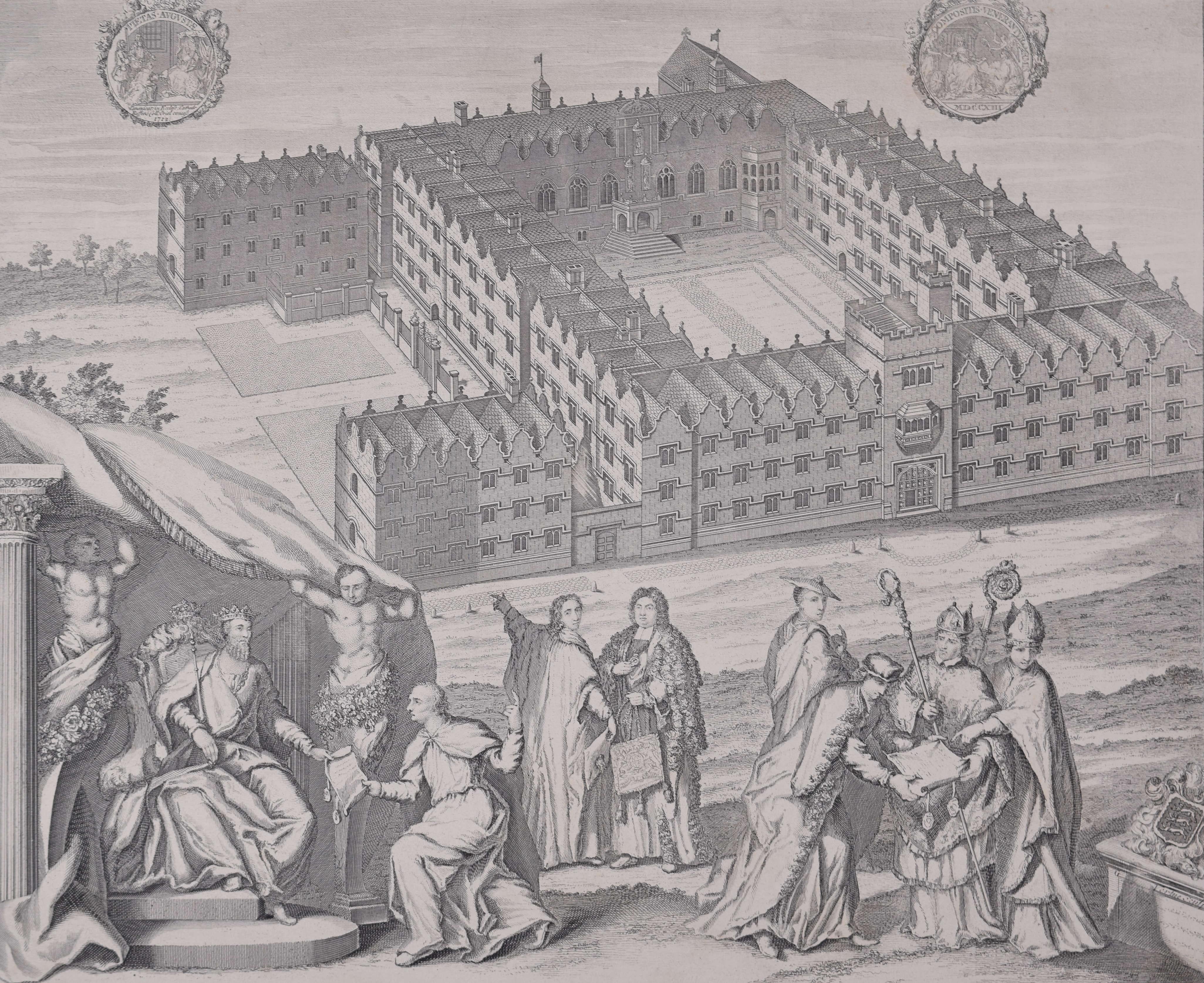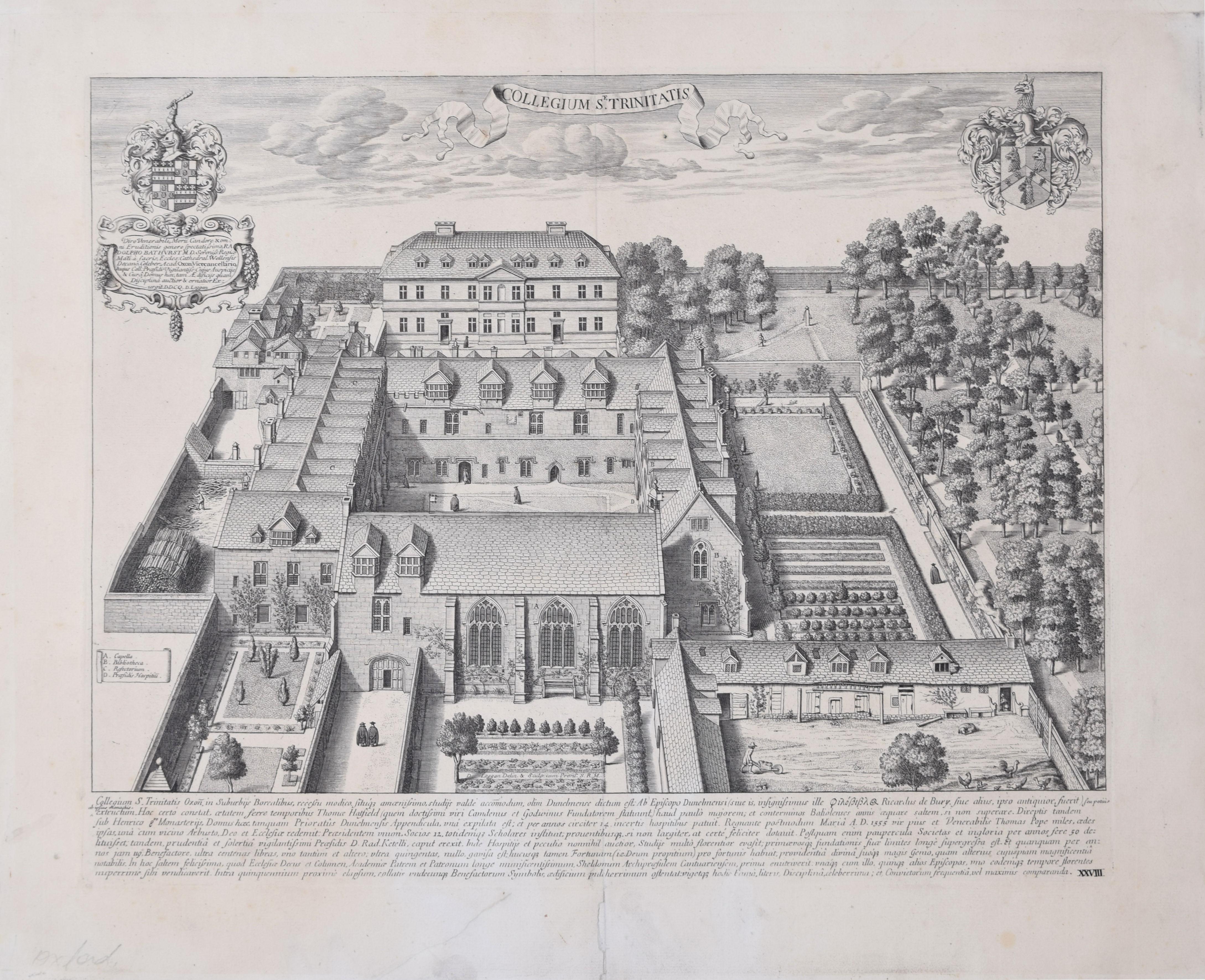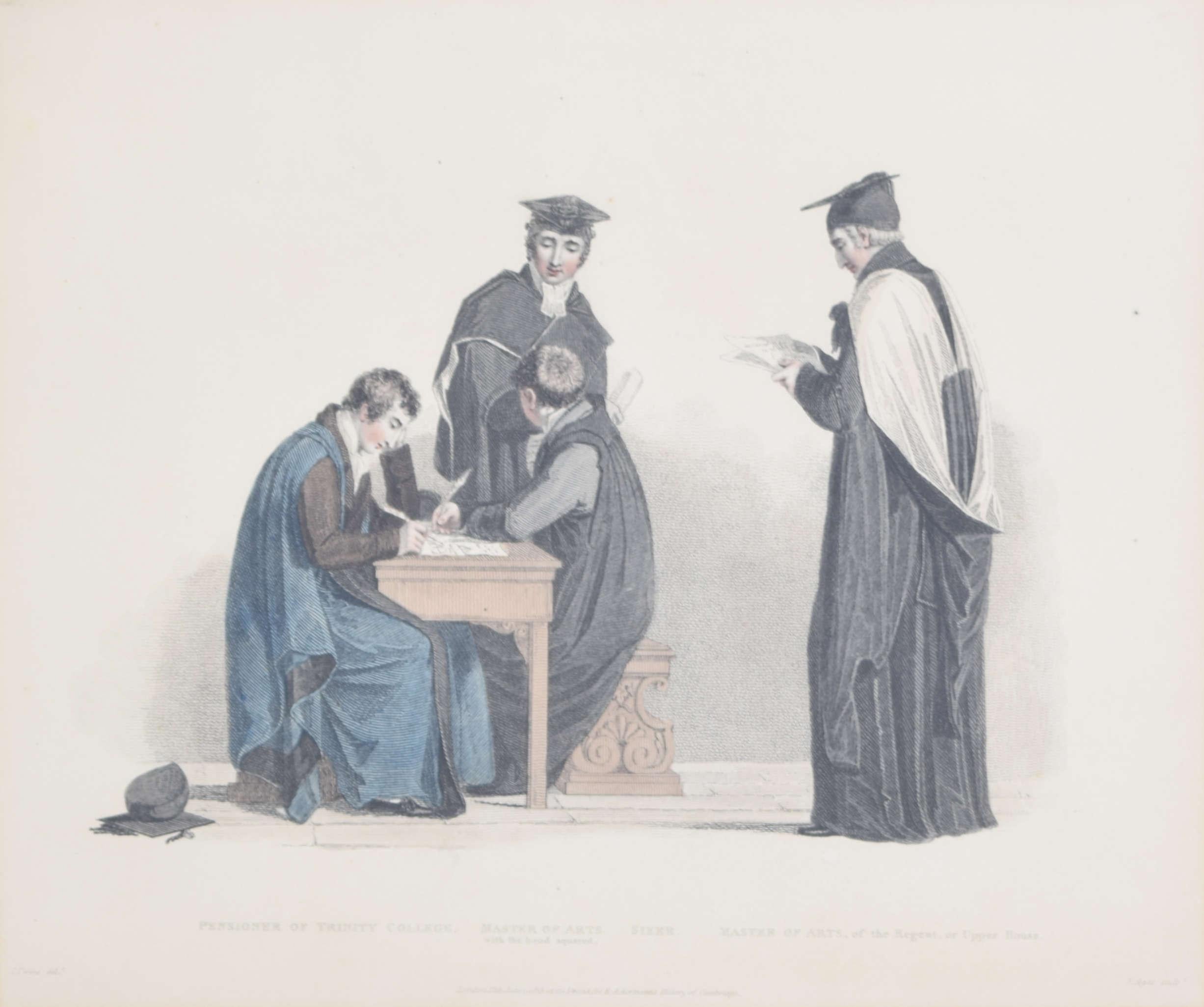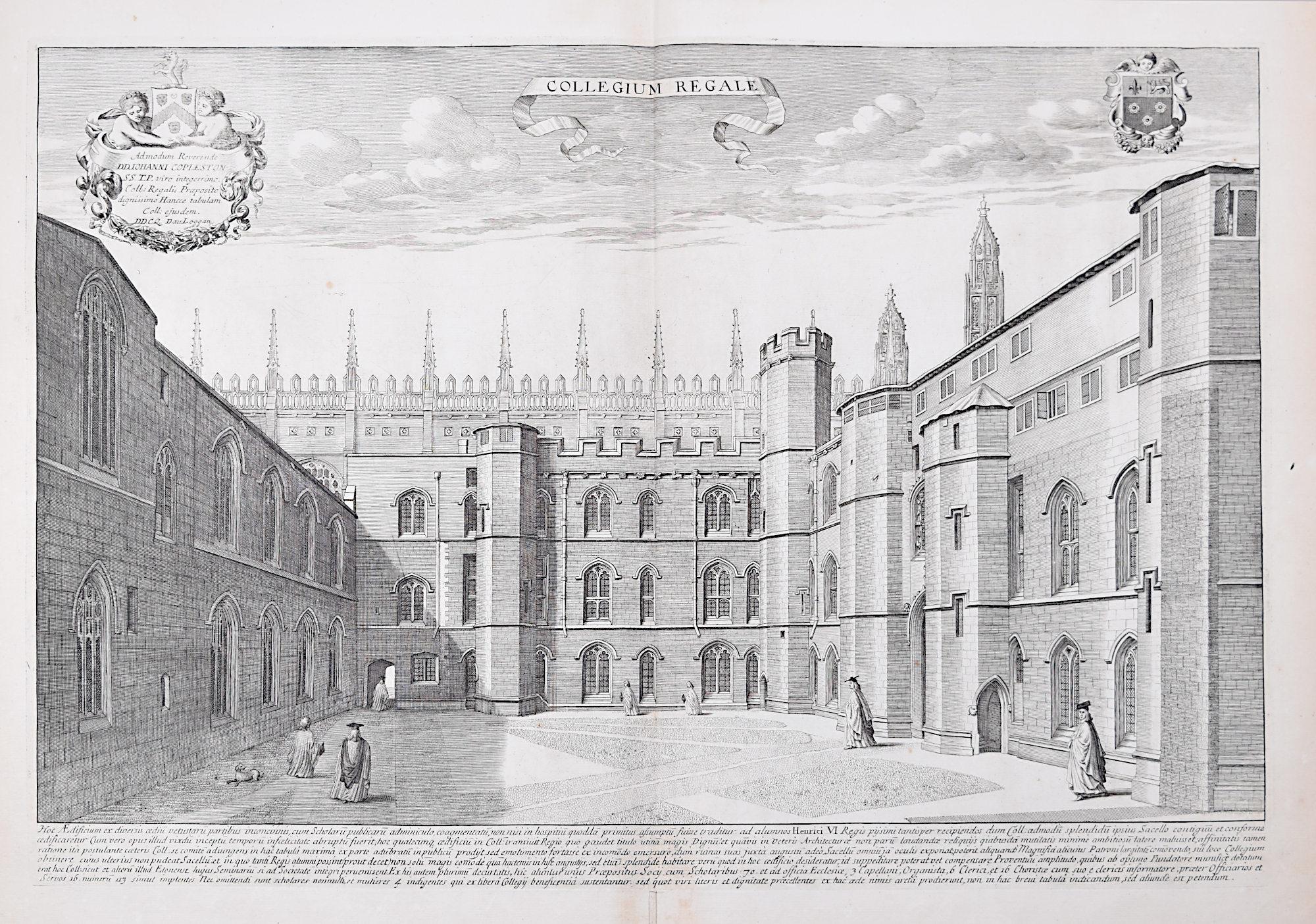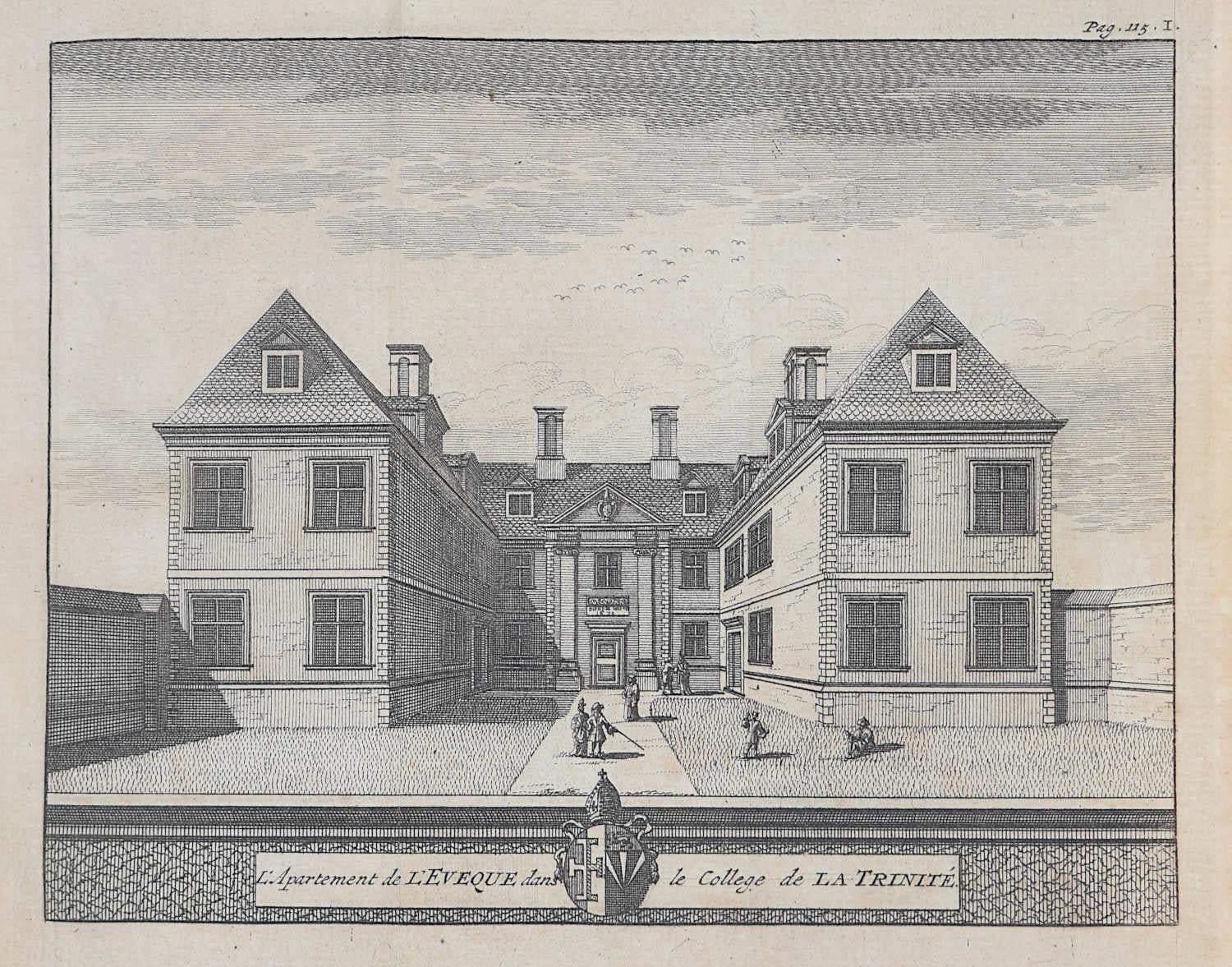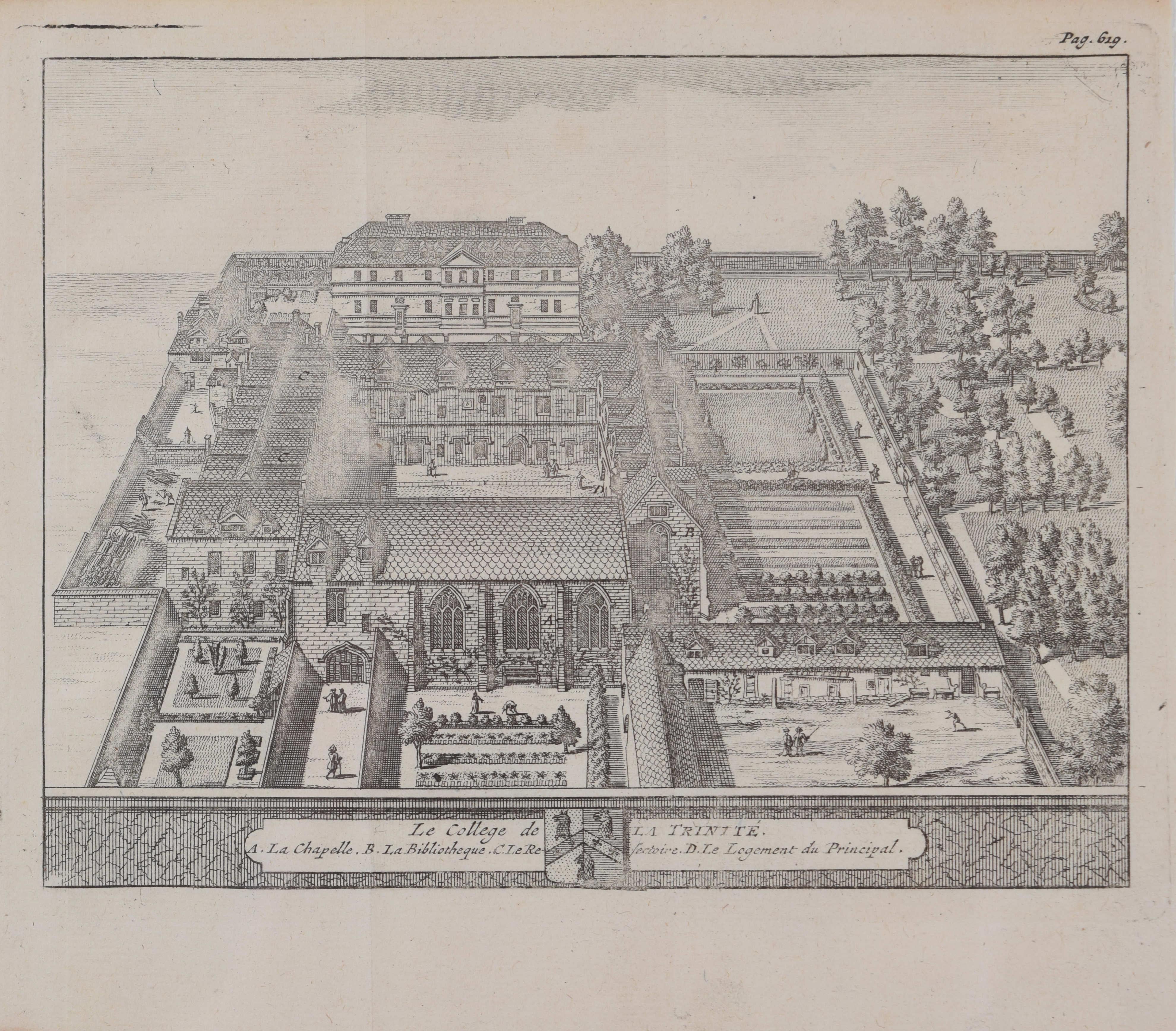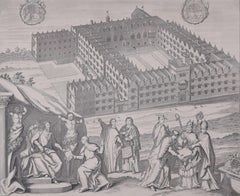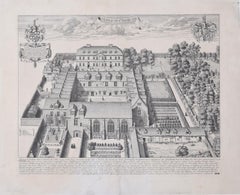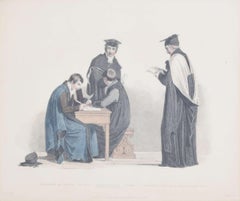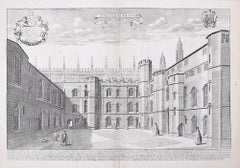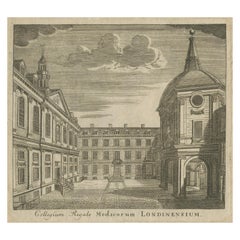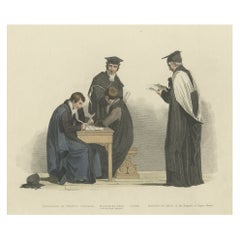Items Similar to The Founder and Benefactors of Trinity College, Oxford, 18th Century engraving
Want more images or videos?
Request additional images or videos from the seller
1 of 5
UnknownThe Founder and Benefactors of Trinity College, Oxford, 18th Century engravingc. 1700
c. 1700
$884.20
£650
€758.74
CA$1,233.79
A$1,335.83
CHF 710.20
MX$16,111.06
NOK 8,931.17
SEK 8,326.40
DKK 5,666.81
About the Item
To see our other views of Oxford and Cambridge , particularly suitable for wedding and graduation presents, scroll down to "More from this Seller" and below it click on "See all from this Seller" - or send us a message if you cannot find the view you want.
Artist unknown
The Founder and Benefactors of Trinity College
Early 18th century
Hand coloured engraving
36.5 x 47.5 cm
Rare - we have been unable to identify another copy of this print.
This beautifully tinted engraving was originally produced for the 1732 Oxford University Almanack. The founder of Trinity College, Sir Thomas Pope, is pictured holding an image based on John Bereblock’s 1566 engraving; it depicts the quadrangle known today as Durham Quad. Also pictured are Ralph Bathurst (President of Trinity 1664-1704), the archbishop of Canterbury, Gilbert Sheldon; the bishop of Worcester, Robert Skinner, and the bishop of Chester, Nicholas Stratford.
Perhaps what is most notable about this engraving is, however, the background of the college landscape. By 1732 Trinity was well underway in developing a highly elaborate garden, with geometric paths, an avenue of limes, yew hedges trimmed to resemble panelling, and so on. None of this is represented here and the quadrangle is instead exponentially extended. Although these plans ultimately never came to fruition, ideas of a vast expansion persisted throughout the reign of George II and the plans were replicated in the Almanack for 1756.
Complete with vibrant colours and sharp lines, this rare engraving offers a unique historical insight into the transformation of and ambitions for Trinity College, Oxford.
- Creation Year:c. 1700
- Dimensions:Height: 14.38 in (36.5 cm)Width: 18.71 in (47.5 cm)
- Medium:
- Period:
- Condition:Generally good with some spotting and slight overall toning. Trimmed to just within platemark at top and bottom.
- Gallery Location:London, GB
- Reference Number:1stDibs: LU79538691762
About the Seller
4.8
Vetted Professional Seller
Every seller passes strict standards for authenticity and reliability
Established in 2014
1stDibs seller since 2017
361 sales on 1stDibs
Typical response time: 13 hours
- ShippingRetrieving quote...Shipping from: London, United Kingdom
- Return Policy
More From This Seller
View AllOriel College, Oxford 18th century engraving from the Oxford Almanac
Located in London, GB
To see our other views of Oxford and Cambridge, scroll down to "More from this Seller" and below it click on "See all from this Seller" - or send us a message if you cannot find the ...
Category
18th Century Landscape Prints
Materials
Engraving
Trinity College, Oxford David Loggan 1705 engraving
By David Loggan
Located in London, GB
To see our other views of Oxford and Cambridge, scroll down to "More from this Seller" and below it click on "See all from this seller" - or send us a message if you cannot find the view you want.
David Loggan (1634 - 1692)
Trinity College, Oxford (1705)
Engraving
32 x 41 cm
Loggan's view of Trinity from the second edition of the 'Oxonia Illustrata'.
Loggan was born to English and Scottish parents, and was baptised in Danzig in 1634. After studying engraving in Danzig with Willem Hondius (1598-1652 or 1658), he moved to London in the late 1650s, going on to produce the engraved title-page for the folio 1662 Book of Common Prayer. He married in 1663 and moved to Nuffield in Oxfordshire in 1665. Loggan was appointed Public Sculptor to the nearby University of Oxford in the late 1660s, having been commissioned to produce bird’s-eye views of all the Oxford colleges. He lived in Holywell Street as he did this. The 'Oxonia Illustrata' was published in 1675, with the help of Robert White (1645-1704). Following its completion, Loggan began work on his equivalent work for Cambridge; the 'Cantabrigia Illustrata' was finally published in 1690, when he was made engraver to Cambridge University.
The 'Oxonia Illustrata' also includes an engraving of Winchester College...
Category
1670s Realist Landscape Prints
Materials
Engraving
MA Masters of Arts and Trinity College, Cambridge member engraving by John Agar
Located in London, GB
To see our other Oxford and Cambridge pictures, including an extensive collection of works by Ackermann, scroll down to "More from this Seller" and below it click on "See all from this Seller" - or send us a message if you cannot find the view you want.
John Samuel Agar (1773 - 1858) after John Uwins (1782 - 1857)
Pensioner of Trinity College, Cambridge, Masters of Arts, and Sizer (1815)
Hand-coloured aquatint
25 x 30 cm
Published by Rudolph Ackermann (1764 - 1834).
An engraving of a pensioner of Trinity College, Masters of Arts, and a sizer (that is, an undergraduate who received some form of assistance such as meals, lower fees or lodging during his period of study, in some cases in return for doing a defined job) from Ackermann's 'A History of the University of Cambridge, Its Colleges, Halls and Public Buildings'. The four figures walk forward with ceremonial accoutrements, possibly to a graduation ceremony.
At Cambridge, a sizar was originally an undergraduate student who financed his studies by undertaking more or less menial tasks within his college but, as time went on, was increasingly likely to receive small grants from the college. Certain colleges, including St John's and Trinity, distinguished between two categories of sizar: there were specific endowments for specific numbers of sizars who were called "proper sizars"; those who were not so endowed, but who were maintained by fellow-commoners and fellows were called subsizars. Isaac Newton matriculated as subsizar at Trinity College. Richard S. Westfall noted that sizars were considerably more successful in gaining degrees than the gentlemen who entered Cambridge in the seventeenth century. Pensioners, on the other hand, paid a fixed annual fee in order to study.
Thomas Uwins RA RWS was a British painter in watercolour and oil, and a book illustrator. He became a full member of the Old Watercolour Society and a Royal Academician, and held a number of high-profile art appointments including the librarian of the Royal Academy, Surveyor of Pictures to Queen Victoria and the Keeper of the National Gallery. In the late 1790s he began producing work for Ackermann's collections.
John Samuel Agar was an English portrait painter and engraver, who exhibited his works at the Royal Academy from 1796 to 1806 and at the British Institution until 1811. He was at one time president of the Society of Engravers. Rudolph Ackermann published many of his engravings.
Ackermann was an Anglo-German bookseller, inventor, lithographer, publisher and businessman. He attended the Latin school in Stollberg, but his wish to study at the university was made impossible by lack of financial means, and he therefore became a saddler like his father.
He worked as a saddler and coach-builder in different German cities, moved from Dresden to Basel and Paris, and then, 23 years old, settled in London. He established himself in Long Acre, the centre of coach-making in London and close to the market at Covent Garden.
Ackermann then moved to Little Russell Street where he published Imitations of Drawings of Fashionable Carriages (1791) to promote his coach-making. Other publications followed. In 1795 he established a print-shop and drawing-school at 96 Strand. Here Ackermann set up a lithographic press and began a trade in prints. He later began to manufacture colours and thick carton paper for landscape and miniature painters. Within three years the premises had become too small and he moved to 101 Strand, in his own words "four doors nearer to Somerset House", the seat of the Royal Academy of Arts.
Between 1797 and 1800 Ackermann rapidly developed his print and book publishing business, encompassing many different genres including topography, caricature, portraits, transparencies and decorative prints.
During the Napoleonic wars, Ackermann was an energetic supporter of the Allied cause and made significant contributions to British propaganda through his publication of anti-Napoleonic prints...
Category
1810s Prints and Multiples
Materials
Aquatint
David Loggan King's College Cambridge engraving 1690
By David Loggan
Located in London, GB
To see our other views of Oxford and Cambridge, scroll down to "More from this Seller" and below it click on "See all from this Seller" - or send us a message if you cannot find the view you want.
David Loggan (1634-1692)
King's College Cambridge
Engraving
1690
40x51cm
Baptised in Danzig in 1634 Loggan's parents were English and Scottish. Studying engraving in Danzig with Willem Hondius (1598-1652 or 1658) he moved to London in the late 1650s producing the engraved title-page for the folio 1662 Book of Common Prayer. Marrying in 1663 he moved to Nuffield, Oxfordshire in 1665 to avoid the Plague and was in 1668/9 appointed Public Sculptor to the nearby University of Oxford having been commissioned to produce bird’s-eye views of all the Oxford Colleges. He lived in Holywell Street as he did this. Oxonia illustrata was published in 1675, with the help of Robert White (1645-1704). Following its completion he commenced work on his equivalent work for Cambridge, Cantabrigia Illustrata which was finally published in 1690 when he was made engraver to Cambridge University.
Oxonia illustrata also includes an engraving of Winchester College (sharing its founder – William of Wykeham – with New College) whilst Cantabrigia illustrata includes one of Eton College (which shares its founder – Henry VIII – with King’s College).
Bird’s-eye views required a particular talent as an architectural perspectivist of that era as it was not until 1783 that the first living thing (a sheep, named Montauciel ‘climb to the sky’) was sent aloft by the Mongolfier brothers in a balloon. Loggan thus had to rely on his imagination in conceiving the views.
Loggan’s views constitute the first accurate depictions of the two Universities, in many ways unchanged today. Whilst the Oxford engravings were produced in reasonable numbers and ran to a second edition by Henry Overton (on thicker paper and with a plate number in the bottom right-hand corner), those of Cambridge were printed in smaller numbers and it is thought largely no second edition was produced.
The Dutchman Pieter van der Aa published some miniature versions of the engravings for James Beverell’s guidebook to the UK Les Delices de la Grande Bretagne c. 1708.
Edmund Hort New (1871-1931) produced a series of pen-and-ink drawings of views of Oxford that paid homage to Loggan showing the development of the city in the following two hundred years. They were turned into photoengravings by Emery Walker...
Category
1690s Realist Prints and Multiples
Materials
Engraving
Trinity College, Cambridge engraving Pieter van der Aa after David Loggan iii
By Pieter Van Der Aa
Located in London, GB
Pieter van der Aa (1659 - 1733), after David Loggan (1634 - 1692)
Trinity College, Cambridge
Engraving
12 x 16 cm
An eighteenth-century view of the Bishop's Hostel in Trinity Colleg...
Category
Early 18th Century Realist Prints and Multiples
Materials
Engraving
Trinity College, Oxford engraving by Pieter van der Aa after David Loggan
By Pieter Van Der Aa
Located in London, GB
Pieter van der Aa (1659-1733), after David Loggan (1634–1692)
Trinity College, Oxford
Engraving
12 x 16 cm
An eighteenth-century view of Trinity College, engraved by Pieter van der ...
Category
Early 18th Century Prints and Multiples
Materials
Engraving
You May Also Like
Antique Engraving – Royal College of Physicians, Warwick Lane, London, 1746
Located in Langweer, NL
Antique Engraving – Royal College of Physicians, Warwick Lane, London, 1746
This finely executed 18th-century engraving depicts the courtyard of the Royal College of Physicians at W...
Category
Antique Mid-18th Century German Prints
Materials
Paper
Old Print of Nobleman and Fellow-Commoners of Trinity and Emanuel College, 1815
By Ackermann and Fritze 1
Located in Langweer, NL
Antique print titled 'Fellow Commoner of Emanuel College - Nobleman - Fellow Commoner of Trinity College'. Portraits of a Fellow Commoner of Emanuel, Nobleman, and Fellow Commoner of...
Category
Antique 19th Century Prints
Materials
Paper
$342 Sale Price
20% Off
Antique Frontispiece of Volume about Great-Britain, 1754
Located in Langweer, NL
Antique frontispiece of the 1st volume of 'Hedendaagsche Historie of Tegenwoordige staat van Groot Brittannie behelsende de beschrijving van Engeland ,Schotland en Ierland'. This vol...
Category
Antique 18th Century Prints
Materials
Paper
Nice Antique Print of a Master in Arts and Academics of Trinity College, 1815
Located in Langweer, NL
Antique print titled 'Pensioner of Trinity College - Master of Arts - Sizer - Master of Arts, of the regent, or Upper House'. Portraits of four men in academic costumes; a college ca...
Category
Antique 19th Century English Prints
Materials
Paper
$342 Sale Price
20% Off
Portraits - Original Etching by Thomas Holloway - 1810
By Thomas Holloway
Located in Roma, IT
Portraits is an original etching artwork realized by Thomas Holloway for Johann Caspar Lavater's "Essays on Physiognomy, Designed to Promote the Knowledge and the Love of Mankind", L...
Category
1810s Modern Figurative Prints
Materials
Etching
Collegio Romano - Etching by Giuseppe Vasi - Late 18th Century
By Giuseppe Vasi
Located in Roma, IT
Collegio Romano is an original black and white etching of the Late 18th century realized by Giuseppe Vasi.
The beautiful etching represents a glimpse of Rome.
Signed and titled on ...
Category
Late 18th Century Old Masters Figurative Prints
Materials
Etching
More Ways To Browse
Rare Engravings
Hand Coloured Engravings
Whale Shark
William A Smith
Wpa Art California
Yayoi Kusama Signed Art
Zinkeisen Doris
16th Century Antiques
19th Century Oil Painting Of Greyhound
Abraham And Isaac
Antique Cavalier King Charles Spaniel Paintings
Antique Fox Hunting Paintings
Antique Pig Oiler
Art Signed Kent
Baie Des Anges
Barbara Woods Paintings
Basquiat Exhibition Poster
Benjamin Herring
